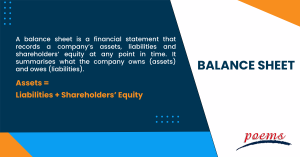Balance Sheet
Table of Contents
What is a Balance Sheet?

A balance sheet is a financial statement that records a company’s assets, liabilities and shareholders’ equity at any point in time. It summarises what the company owns (assets) and owes (liabilities).
In a balance sheet:
Assets = Liabilities + Shareholders’ Equity
This equation arises from the way accounts are kept using the double-entry accounting principle. Each side of the equation must match the other: when one account is debited, another must be credited.
Example of a Balance Sheet
Suppose Company XYZ takes a 5-year loan of US$4,000 from a bank. Its assets column, which includes its cash account, will now have US$4,000 more. Similarly, its liabilities column will increase by US$4,000.
If XYZ takes US$8,000 from investors, its assets column will increase by US$8,000. So will its shareholders’ equity entry.
How is a Balance Sheet Structured?
A balance sheet typically has five sections:
- Current Assets: These are assets that can be liquidated in a short period of time.
- Cash and Equivalents: Funds in current and savings accounts and money market instruments.
- Accounts Receivable: Payments pending from customers.
- Inventory: Raw materials or finished goods held by the company.
- Non-Current Assets: These refer to assets that a firm owns for the long term.
- Plant, Property and Equipment: Physical or tangible long-term assets that have a lifespan of more than one year. Examples are buildings, machinery, land, office equipment, furniture and vehicles.
- Intangible Assets: Non-physical assets like copyrights, patents, brands, trademarks that the company owns.
- Current Liabilities: These are obligations that are due in a short period, generally under a year.
- Accounts Payable: Money owed by the business for items that are bought on credit.
- Current Debt/Notes Payable: Debt that needs to be cleared within a year.
- Current Portion of Long-Term Debt: The portion of long-term debtthat must be paid within the current year.
- Non-Current Liabilities: Obligations or debts that need to be paid beyond the current financial year.
- Bonds Payable: Amount owed to bond holders by the company.
- Long-Term Debt: Debt thatmatures in more than one year.
- Shareholders’ Equity: Funds invested in the company by its stakeholders.
- Share Capital: Themoney a company raises by issuing common or preferred stock.
- Retained Earnings: The portion of net income after the company pays out dividends that is reinvested in the business for future growth purposes.
What can a Balance Sheet Tell You About a Company?
The balance sheet is typically read in conjunction with a company’s income statement and cash flow statement to provide a holistic picture of its financial position. The financial metrics that one can derive from these financial statements are:
- Liquidity: One can assess the liquidity of a firm by comparing its current assets to its current liabilities.
- Efficiency: Efficiency ratios show how well a company is using its assets and liabilities. Efficiency ratios are calculated from numbers in the income statement and balance sheet.
- Rates of Returns: Investors also use the balance sheet to estimate potential rates of returns on their investments. Common measurements of returns are Returns on Equity (ROE), Returns on Assets (ROA) and Returns on Invested Capital (ROIC)
Importance of Balance Sheets
The balance sheet is a snapshot of the financial status of a company. It tells investors what a business owns (assets), what it owes (liabilities) and how much investors have invested (equity) in the company at a particular point in time. It gives one an indication of how much money the company would have left after selling all its assets and paying off all its debts.
Lenders and investors often look at balance sheets to help them decide whether to lend to or invest in a company and by how much.
Frequently Asked Questions
Cash and debt are among the most important items on a balance sheet for investors.
Investors generally look at:
- Liquidity
- Inventory levels
- Accounts receivable
- Cash holdings
- Debt-to-equity ratio
- Return on assets
A strong balance sheet needs to have more assets than liabilities. The balance sheets of financially strong companies typically have healthy cash balances and low debt levels.
One of the most effective ways to compare two businesses is to perform ratio analysis of the two companies using their balance sheets. The ratios include liquidity ratios, solvency ratios and profitability ratios.
Related Terms
- Trailing Stops
- Exchange Control
- Relevant Cost
- Dow Theory
- Hyperdeflation
- Hope Credit
- Futures contracts
- Human capital
- Subrogation
- Qualifying Annuity
- Strategic Alliance
- Probate Court
- Procurement
- Holding company
- Harmonic mean
- Trailing Stops
- Exchange Control
- Relevant Cost
- Dow Theory
- Hyperdeflation
- Hope Credit
- Futures contracts
- Human capital
- Subrogation
- Qualifying Annuity
- Strategic Alliance
- Probate Court
- Procurement
- Holding company
- Harmonic mean
- Income protection insurance
- Recession
- Savings Ratios
- Pump and dump
- Total Debt Servicing Ratio
- Debt to Asset Ratio
- Liquid Assets to Net Worth Ratio
- Liquidity Ratio
- Personal financial ratios
- T-bills
- Payroll deduction plan
- Operating expenses
- Demand elasticity
- Deferred compensation
- Conflict theory
- Acid-test ratio
- Withholding Tax
- Benchmark index
- Double Taxation Relief
- Debtor Risk
- Securitization
- Yield on Distribution
- Currency Swap
- Overcollateralization
- Efficient Frontier
- Listing Rules
- Green Shoe Options
- Accrued Interest
- Market Order
- Accrued Expenses
- Target Leverage Ratio
- Acceptance Credit
- Balloon Interest
- Abridged Prospectus
- Data Tagging
- Perpetuity
- Hybrid annuity
- Investor fallout
- Intermediated market
- Information-less trades
- Back Months
- Adjusted Futures Price
- Expected maturity date
- Excess spread
- Quantitative tightening
- Accreted Value
- Equity Clawback
- Soft Dollar Broker
- Stagnation
- Replenishment
- Decoupling
- Holding period
- Regression analysis
- Wealth manager
- Financial plan
- Adequacy of coverage
- Actual market
- Credit risk
- Insurance
- Financial independence
- Annual report
- Financial management
- Ageing schedule
- Global indices
- Folio number
- Accrual basis
- Liquidity risk
- Quick Ratio
- Unearned Income
- Sustainability
- Value at Risk
- Vertical Financial Analysis
- Residual maturity
- Operating Margin
- Trust deed
- Leverage
- Profit and Loss Statement
- Junior Market
- Affinity fraud
- Base currency
- Working capital
- Individual Savings Account
- Redemption yield
- Net profit margin
- Fringe benefits
- Fiscal policy
- Escrow
- Externality
- Multi-level marketing
- Joint tenancy
- Liquidity coverage ratio
- Hurdle rate
- Kiddie tax
- Giffen Goods
- Keynesian economics
- EBITA
- Risk Tolerance
- Disbursement
- Bayes’ Theorem
- Amalgamation
- Adverse selection
- Contribution Margin
- Accounting Equation
- Value chain
- Gross Income
- Net present value
- Liability
- Leverage ratio
- Inventory turnover
- Gross margin
- Collateral
- Being Bearish
- Being Bullish
- Commodity
- Exchange rate
- Basis point
- Inception date
- Riskometer
- Trigger Option
- Zeta model
- Racketeering
- Market Indexes
- Short Selling
- Quartile rank
- Defeasance
- Cut-off-time
- Business-to-Consumer
- Bankruptcy
- Acquisition
- Turnover Ratio
- Indexation
- Fiduciary responsibility
- Benchmark
- Pegging
- Illiquidity
- Backwardation
- Backup Withholding
- Buyout
- Beneficial owner
- Contingent deferred sales charge
- Exchange privilege
- Asset allocation
- Maturity distribution
- Letter of Intent
- Emerging Markets
- Consensus Estimate
- Cash Settlement
- Cash Flow
- Capital Lease Obligations
- Book-to-Bill-Ratio
- Capital Gains or Losses
- Capital Lease
Most Popular Terms
Other Terms
- Physical ETF
- Initial Public Offering
- Buyback
- Secondary Sharing
- Bookrunner
- Notional amount
- Negative convexity
- Jumbo pools
- Inverse floater
- Forward Swap
- Underwriting risk
- Reinvestment risk
- Final Maturity Date
- Payment Date
- Secondary Market
- Margin Requirement
- Mark-to-market
- Pledged Asset
- Yield Pickup
- Subordinated Debt
- Treasury Stock Method
- Stochastic Oscillator
- Bullet Bonds
- Basket Trade
- Contrarian Strategy
- Notional Value
- Speculation
- Stub
- Trading Volume
- Going Long
- Pink sheet stocks
- Rand cost averaging
- Sustainable investment
- Stop-limit sell order
- Economic Bubble
- Ask Price
- Constant prepayment rate
- Covenants
- Stock symbol
- Companion tranche
- Synthetic replication
- Bourse
- Beneficiary
- Witching Hour
- Widow and Orphan stock
- Public Float
- Closing Price
- Reverse stock splits
- Quiet period
- Prepayment risk
Know More about
Tools/Educational Resources
Markets Offered by POEMS
Read the Latest Market Journal

Weekly Updates 15/4/24 – 19/4/24
This weekly update is designed to help you stay informed and relate economic and company...

From $50 to $100: Unveiling the Impact of Inflation
In recent years, inflation has become a hot topic, evoking strong emotions as the cost...

Japan’s Economic Resurgence: Unveiling the Tailwinds Behind Nikkei 225’s Record Leap
Source: eSignal, Intercontinental Exchange, Inc. In the heart of Japan’s economic landscape, the Nikkei 225...

Weekly Updates 8/4/24 – 12/4/24
This weekly update is designed to help you stay informed and relate economic and...

What Makes Forex Trading Attractive?
In a world where the click of a button can send goods across oceans and...

Weekly Updates 1/4/24 – 5/4/24
This weekly update is designed to help you stay informed and relate economic and company...

How to soar higher with Positive Carry!
As US Fed interest rates are predicted to rise 6 times this year, it’s best...

Why 2024 Offers A Small Window of Opportunity and How to Position Yourself to Capture It
With the Federal Reserve (FED) finally indicating rate cuts in 2024, we witnessed a significant...


















